
Original Link: https://www.anandtech.com/show/2489
Higher Clock Speeds, No TLB Issues and Better Pricing: The New Phenom
by Anand Lal Shimpi on March 27, 2008 12:00 AM EST- Posted in
- CPUs
When Phenom launched it was slow, later plagued by a performance-hindering TLB bug and priced entirely out of the realm of rational thought. It's a new year and while I'd like to say that AMD has learned from all of its mistakes and will be back to a fully competitive state, that's only mostly true. There are still significant struggles within the company but at least this launch is a step in the right direction.
Today's launch is actually much bigger than Phenom's original debut, encompassing a total of seven new processors:
| Cores | Stepping | Clock Speed | TDP | L2 Cache | L3 Cache | 1 Ku Price | |
| AMD Phenom X4 9850 | 4 | B3 | 2.5GHz | 125W | 2MB | 2MB | $235 |
| AMD Phenom X4 9750 | 4 | B3 | 2.4GHz | 125W | 2MB | 2MB | $215 |
| AMD Phenom X4 9750* | 4 | B3 | 2.4GHz | 95W | 2MB | 2MB | $??? |
| AMD Phenom X4 9650* | 4 | B3 | 2.3GHz | 95W | 2MB | 2MB | $??? |
| AMD Phenom X4 9550 | 4 | B3 | 2.2GHz | 95W | 2MB | 2MB | $195 |
| AMD Phenom X4 9100e* | 4 | B2 | 1.8GHz | 65W | 2MB | 2MB | ~$200 |
| AMD Phenom X3 8600* | 3 | B2 | 2.3GHz | 95W | 1.5MB | 2MB | ~$175 |
| AMD Phenom X3 8400* | 3 | B2 | 2.1GHz | 95W | 1.5MB | 2MB | ~$150 |
Ok, let's see if we can make sense of this. There are three new CPUs that you'll see at places like Newegg: the Phenom X4 9850, Phenom X4 9750 and Phenom X4 9550 running at 2.5GHz, 2.4GHz and 2.2GHz respectively. The 50 at the end of the model number means that these CPUs are based on the new B3 stepping, which includes the fix for the TLB erratum - in other words, these are the CPUs you want. The prices are also pretty reasonable, they are all finally cheaper than Intel's Core 2 Quad Q6600.

The Phenom X4 9850 is a "Black Edition" part, meaning it ships with its clock multiplier unlocked. It is also the first Phenom to run its L3 cache/North Bridge/memory controller at 2.0GHz and not 1.8GHz like the rest of the Phenom lineup.
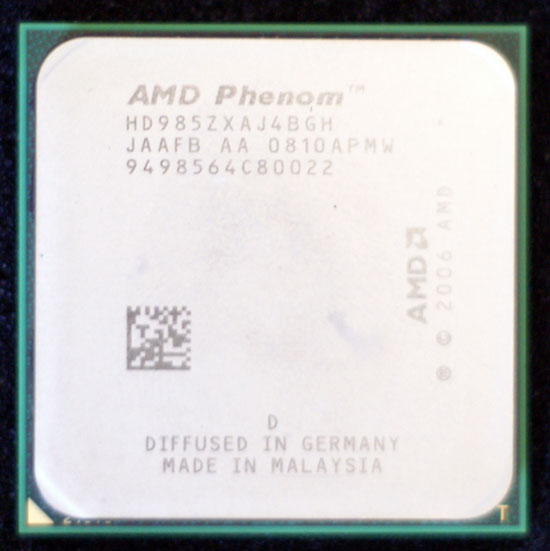
Here's where it gets complicated. AMD needed something to do with all of its B2 stepping Phenoms, so it's selling those to OEMs who don't really seem to care about the TLB bug. The CPUs with a * next to them are OEM only; although that doesn't mean that they won't appear in retail, they aren't intended for end user purchase.
The Phenom X4 9100e is AMD's first 65W TDP quad core CPU thanks to a relatively low operating frequency of 1.8GHz. Unfortunately it's plagued by the TLB bug since it's a B2 stepping core, so you have to take into account that its performance may suffer because of it. The same applies to the two new triple-core parts; the Phenom X3 8600 and 8400 are both quad core B2 stepping CPUs with one of the cores disabled. AMD doesn't have any plans to introduce a new, smaller triple-core die because the costs would be too great. Instead AMD wants to focus on getting its 45nm transition started before the end of the year.
AMD's plan is quite ingenious, keep the TLB bug CPUs out of the hands of the enthusiasts who will complain and use them to keep OEMs happy as well as use them for the first triple-core CPUs.
The OEMs don't completely get the shaft as there are two 50-series CPUs they get that we don't. First off there's a 95W TDP Phenom X4 9750 (most likely a lower yielding 9750 that just runs a bit cooler, hence the lower TDP) and next there's a Phenom X4 9650.
Within the next month or so, AMD will be releasing B3 versions of all of the remaining CPUs, so you'll see a Phenom X4 9150e, Phenom X3 8650 and Phenom X3 8400. In general, AMD told us to expect around a $50 price difference at the same clock speed between triple and quad core. Given that most applications still don't benefit tremendously from four cores, tri-core may be a nice way for AMD to compete with Intel's higher performing dual core options. As soon as there are B3 Phenom X3s available for review, we'll let you know how they stack up.
3.0GHz: Where Are You?
AMD ran a controversial demo of a quad core Phenom in July of last year:
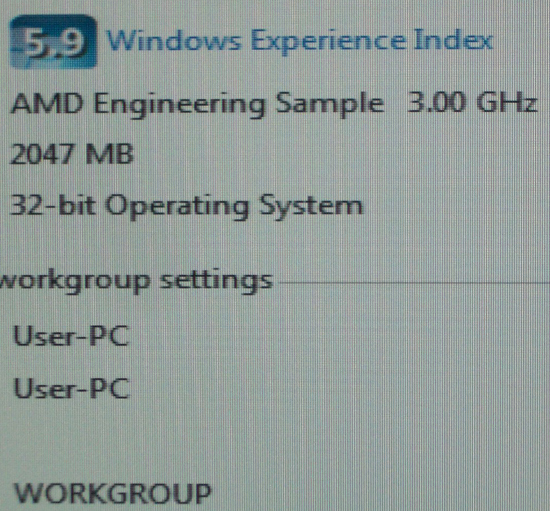
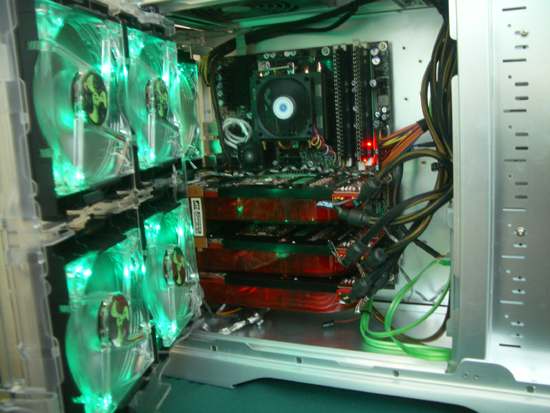
The demo ran at 3.0GHz and was designed to set expectations for Phenom. The problem is that when Phenom launched, it did so at 2.3GHz. Even today we're only at 2.5GHz. Allow me to quote, um, myself:
"In a demonstration designed to prove that Phenom isn't broken, AMD featured a quad core Phenom X4 processor, with standard cooling, running at 3.0GHz. While Phenom won't be anywhere near that clock speed when it launches at the end of this year, AMD expects to be at 3GHz within the first half of 2008. "
AMD told some members of the press that there was nothing special about these 3.0GHz Phenoms that were demoed, which begs the question - what happened?
There's nothing particularly magical about the 3.0GHz number, but the problem is this: Intel gives you two options at $266, you can purchase a Core 2 Duo E6850 (3.00GHz, dual core) or you can purchase a Core 2 Quad Q6600 (2.40GHz, quad core). The difference in clock frequency is 600MHz but you get two more cores, for the same price.
With AMD, the decision isn't as simple. At $178 you can purchase an Athlon 64 X2 6400+ Black Edition (3.2GHz, dual core), or at $195 you can buy a Phenom X4 9550 (2.2GHz, quad core). Not only do you have to spend a little more to get four cores, but you give up 1000MHz in clock frequency. Thankfully Phenom has some architectural enhancements that help narrow the performance gap, but it still does make AMD's job of competing much more difficult - forcing it to dramatically reduce prices.
Phenom could scale much higher, after all the individual cores aren't all that more complex than those in an Athlon 64 X2. We get the impression that there are some speed paths that could be optimized on the current B2 and B3 Phenoms that simply aren't because of a very sensible thought process. AMD is still on track to begin shipping its first 45nm Phenom processors (Deneb core) by the end of this year and it doesn't make sense to waste time and resources respinning a 65nm Phenom, when presumably these clock speed issues are addressed at 45nm.
AMD is expecting, clock for clock, 45nm Deneb based Phenom cores to offer up to 15% more performance (we're skeptical of that number). AMD also committed to matching clock speeds of 65nm Phenom processors when the 45nm parts launch. If Phenom is at 2.7GHz when 45nm launches, the first 45nm parts will come in at 2.7GHz (as well as models lower/higher obviously, but the point is that there will be clock speed parity with the move to 45nm).
Overclocking B3, a Little Better
Despite the new 50 series CPUs being a new spin of silicon, the only changes AMD made (that we are aware of at least) were to fix the TLB erratum. We were told not to expect any significant increases in clock frequency out of B3, it was simply a functional change. However, with Phenom having been in production for a little while now it's possible that we could get a little more out of our B3 chips than the first Phenom processors we tested late last year.
Using stock cooling on air we wanted to see how things had changed in four months. Armed with our unlocked Phenom X4 9850, we wanted to see what was possible.
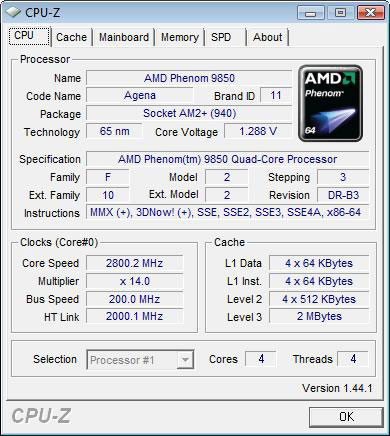
We went straight for 2.8GHz at stock voltage, which surprisingly enough POSTed and got us into Windows without any problems. The system wasn't stable enough to complete most of our benchmarks however, we needed to boost the core voltage a bit:
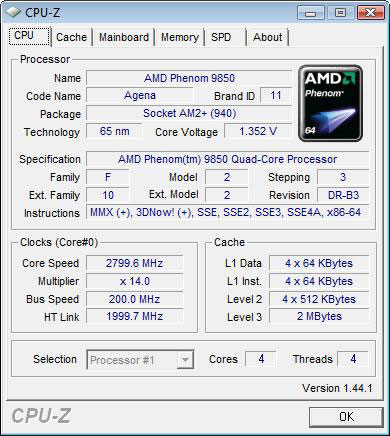
Note that this is better than any of our previous attempts with Phenom. While we could hit 3.0GHz in the past, it was never stable enough to complete all of our benchmarks. While we only had a few hours left over to test the overclocking stability of the 9850 it does look like it may be the first Phenom capable of easily breaking the 2.6GHz barrier.
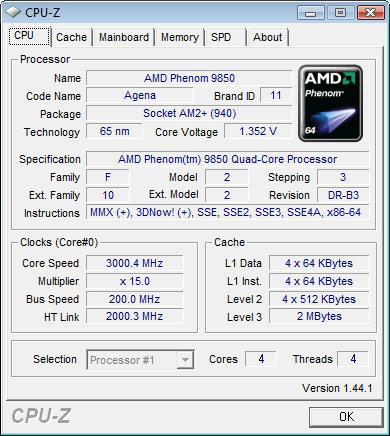
We aimed for 3.0GHz and while we could get into Windows and run some benchmarks, we couldn't get it 100% stable. In our opinion it's highly unlikely we'll see AMD release a 3.0GHz Phenom on 65nm this year. It may be possible on 45nm but it's still too early to tell if that'll be this year or not.
Intel's 45nm CPUs: High Prices and Limited Availability, When Will it End?
Intel launched its first 45nm processors at the end of last year in order to somewhat stick to its annual tick-tock schedule. The Core 2 Extreme QX9650 made it out, but what everyone wanted were the mainstream chips - affordable 45nm for all.
At CES, Intel announced its full 45nm lineup which is as follows:
| Cores | Clock Speed | L2 Cache Size | FSB | 1 Ku Price | Availability | |
| Intel Core 2 Extreme X9000 | 2 | 2.80GHz | 6MB | 800MHz | $851 | January |
| Intel Core 2 Duo T9500 | 2 | 2.60GHz | 6MB | 800MHz | $530 | January |
| Intel Core 2 Duo T9300 | 2 | 2.50GHz | 6MB | 800MHz | $316 | January |
| Intel Core 2 Duo T8300 | 2 | 2.40GHz | 3MB | 800MHz | $241 | January |
| Intel Core 2 Duo T8100 | 2 | 2.10GHz | 3MB | 800MHz | $209 | January |
| Intel Xeon X3360 | 4 | 2.83GHz | 12MB | 1333MHz | $530 | Q1 '08 |
| Intel Xeon X3350 | 4 | 2.66GHz | 12MB | 1333MHz | $316 | Q1 '08 |
| Intel Xeon X3320 | 4 | 2.50GHz | 6MB | 1333MHz | $266 | Q1 '08 |
| Intel Xeon E3110 | 2 | 3.00GHz | 6MB | 1333MHz | $188 | Q1 '08 |
| Intel Core 2 Quad Q9550 | 4 | 2.83GHz | 12MB | 1333MHz | $530 | Q1 '08 |
| Intel Core 2 Quad Q9450 | 4 | 2.66GHz | 12MB | 1333MHz | $316 | Q1 '08 |
| Intel Core 2 Quad Q9300 | 4 | 2.50GHz | 6MB | 1333MHz | $266 | Q1 '08 |
| Intel Core 2 Duo E8500 | 2 | 3.16GHz | 6MB | 1333MHz | $266 | January |
| Intel Core 2 Duo E8400 | 2 | 3.00GHz | 6MB | 1333MHz | $183 | January |
| Intel Core 2 Duo E8200 | 2 | 2.66GHz | 6MB | 1333MHz | $163 | January |
The first issue we had was that availability wasn't in January. We were able to benchmark mobile Penryn (the first five CPUs on that chart) in January, but you couldn't buy systems based on mobile Penryn until late February. The mobile Penryn issue ended up being more of a motherboard design problem than a chip availability issue, thus it makes sense that we saw desktop 45nm dual core CPUs in early February.
It's almost the end of Q1 and we are just now starting to see 45nm quad core desktop CPUs arrive, but the problem with both these and the 45nm dual core chips is pricing. Take a look at the table below:
| MSRP | Street Price | Premium | |
| Intel Core 2 Quad Q9300 | $266 | $299 | +$33 |
| Intel Core 2 Duo E8400 | $183 | $259 | +$76 |
| Intel Core 2 Duo E8200 | $163 | $239 | +$76 |
Most of the 45nm lineup is still not available for purchase in the channel. The three CPUs we've listed above are the only ones (out of 6) that you can actually purchase at Newegg, and they all sell at a premium. The quad core Q9300 carries the lowest premium of them all at $299, while the two dual core CPUs are selling for $76 more than what they should be thanks to high demand and limited supply.
We know supply is limited, the question is why? Intel's latest roadmap actually helps answer that. The chart below shows a breakdown of processor shipments into the consumer desktop space as a function of time, so you get an idea for the breakdown of 65nm vs. 45nm for each quarter of 2008:

Current 65nm Core 2 Quads sell for MSRP and they are represented by the second block (light blue) at the top of the Q1 stacked bar. The 45nm Core 2 Quad supply is but a sliver by comparison (5% of Intel's shipments are 65nm Core 2 Quads, while 2% are 45nm Core 2 Quads). It would be safe to assume that once Intel's 45nm Core 2 Quad shipments are similar in size to the 65nm shipments today that we should see prices stabilize. If you look at the Q2 bar you'll see that next quarter Intel will produce more 45nm quad core CPUs than 65nm quad core CPUs, and at that point you can expect to see availability of the Q9300, Q9450 and Q9550 - all at reasonable prices, with no premium.
Now let's look at what's happening in the 45nm dual core space. Over 40% of Intel's production in Q1 was 65nm Core 2 Duos, and around 3% were 45nm Core 2 Duo processors - no wonder these things are selling at insane premiums. It's also worth noting that since demand for the dual core CPUs is so much higher than for the quad core chips and supplies are just as tight, the premiums are higher (explaining what we saw in the table above).
Unfortunately, relief for those interested in 45nm dual core won't come for quite a while. In Q2, Intel's 45nm dual core shipments will grow from 3% to 12%, but not to the 40%+ level it needs to be to satisfy demand. The 45nm premium on dual core CPUs will be down from its current levels, but we won't see these things selling at MSRP until Q3.
It's normally a good thing for AMD when Intel CPUs are more expensive, but not exactly in this case. The problem is that AMD needs Intel's quad core CPUs to be more expensive since that's where Phenom is trying to compete, but the Q6600 is still available at MSRP and the Q9300 et al will be selling at MSRP in the next 1 - 3 months.
The Core 2 Quad Q9300: Benchmarked
When Intel launched the Core 2 Quad Q6600 it was an instant hit in the enthusiast community. You didn't have to give up much in clock speed over an equivalently priced dual core (only 266MHz), but you got four very fast cores to do with what you will. When Intel unveiled its 45nm quad core QX9650 we were excited, but what we really wanted was the Q6600's successor.
We knew from looking at Intel's roadmaps that its successor would be the Q9300, priced at $266 (identical to the Q6600, at least on paper) this would be the new Q6600. We had 45nm quad core chips on hand, but we couldn't simulate the Q9300, the table below explains why:
| Clock Speed | L2 Cache Size | FSB | |
| Intel Core 2 Quad Q9450 | 2.66GHz | 12MB | 1333MHz |
| Intel Core 2 Quad Q9300 | 2.50GHz | 6MB | 1333MHz |
| Intel Core 2 Quad Q6600 | 2.40GHz | 8MB | 1066MHz |
While all of the other 45nm quad core CPUs have 12MB of L2 cache on chip (6MB L2 per pair of cores x 2 pairs of cores = 12MB), the Q9300 only has 6MB (3MB L2 per pair of cores x 2 pair = 6MB). The 6MB is also less than the 8MB on the Q6600, but the Q9300 runs 100MHz faster, has a 1333MHz FSB (vs. 1066MHz) and all of the minor architectural tweaks present in Penryn. The question then becomes, is the Q9300 any faster at all than the Q6600?
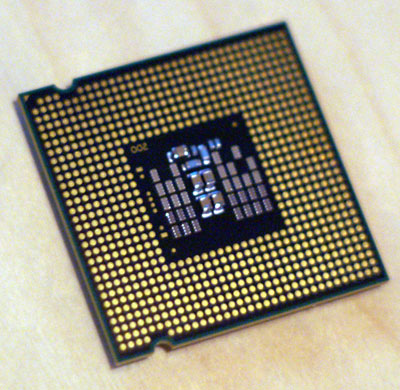
The new Intel Core 2 Quad Q9300
Thankfully we can finally find out. The Q9300 just started shipping and you can now buy them from Newegg, but as we mentioned before they carry a 12% price premium due to limited supply. Assuming that the pricing issues get fixed next quarter, let's see how the Q9300 behaves as a Q6600 successor:

The 7.4% average performance increase over the Q6600 isn't bad at all, especially if we're looking at price-parity. The Q9300 sell becomes even easier when you look at power data:
| System Idle Power | System Load Power | |
| Intel Core 2 Quad Q9300 | 113W | 154W |
| Intel Core 2 Quad Q6600 | 136W | 210W |
The Q9300 can be noticeably faster than the Q6600 depending on the benchmark, and it does so while consuming significantly less power. We'd say that makes a pretty good successor to the first affordable quad core CPU.
Wolfy, How Fast Art Thou?
One of the first things we did when we got our hands on Intel's 45nm quad core parts was determine if they were any faster than the 65nm chips at the same frequency. It turns out that the performance difference wasn't huge, but the power savings at the (theoretically) same cost makes the move to 45nm a step forward.
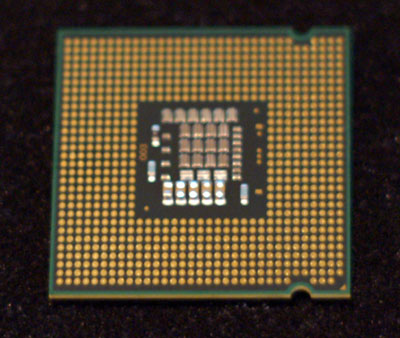
We never did the same for the 45nm dual core (Wolfdale) parts, so here you go.
The new retail Wolfdale (45nm dual core) based CPUs come with a super low profile, very quiet heatsink:
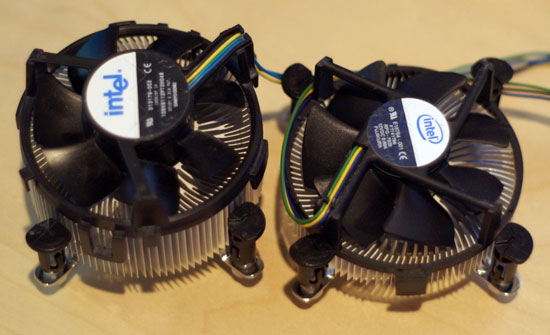
The old heatsink (left), the new heatsink (right)
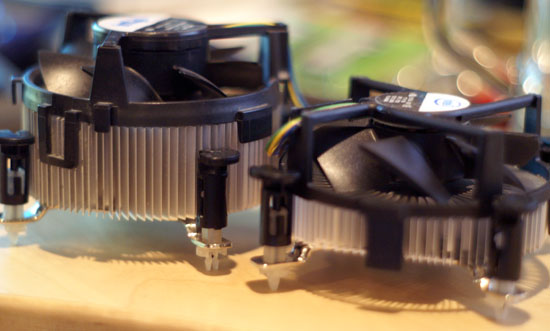
It's so cute
Intel is taking power and performance per watt more seriously now than ever before, you can expect its next designs (Nehalem and beyond) to be even more impressive in this regard.
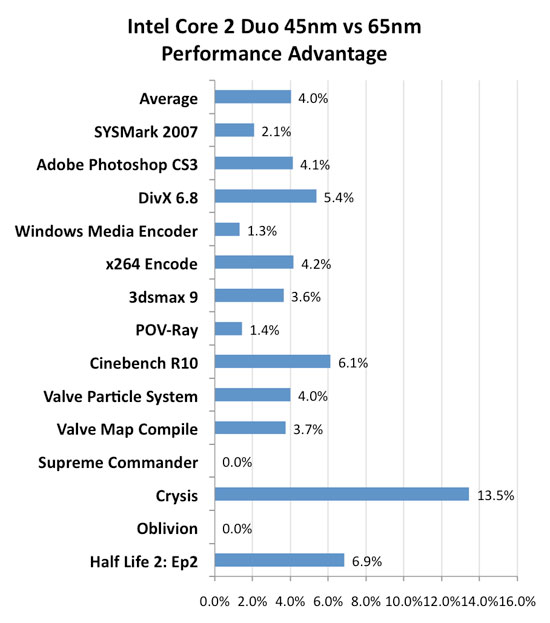
The average performance increase for Intel's 45nm Wolfdale based Core 2 Duo is exactly 4%, which isn't quite as big as what we saw in the Q9300 vs. Q6600 comparison but still something. There are definite, tangible gains in some applications but we're mostly looking at single digital percentage improvements here.
Let's have a look at power:
| System Idle Power | System Load Power | |
| Intel Core 2 Duo E8200 (2.66GHz) | 114W | 138W |
| Intel Core 2 Duo E6750 (2.66GHz) | 116W | 158W |
Power improves, but not as much as the Q9300 did over the Q6600, partially because cache sizes have actually gone up in this case (4MB to 6MB) while they went down with the Q9300 (8MB to 6MB).
We're not expecting to see price parity between the 45nm and 65nm Core 2 Duos until Q3 of this year, waiting will obviously give you a faster, cooler running chip - but not necessarily by a huge amount.
The Test
| CPU: | AMD Phenom 9850 (2.5GHz) AMD Phenom 9750 (2.4GHz) AMD Phenom 9550 (2.2GHz) AMD Phenom 9600 (2.3GHz) AMD Phenom 9500 (2.2GHz) Intel Core 2 Quad Q9300 (2.50GHz/1333MHz) Intel Core 2 Quad Q6600 (2.40GHz/1066MHz) Intel Core 2 Duo E8200 (2.66GHz/1333MHz) Intel Core 2 Duo E6750 (2.66GHz/1333MHz) |
| Motherboard: | ASUS P5E3 Deluxe (X38) MSI K9A2 Platinum (790FX) |
| Chipset: | Intel X38 AMD 790FX |
| Chipset Drivers: | Intel 8.1.1.1010 (Intel) AMD Catalyst 8.3 |
| Hard Disk: | Western Digital Raptor 150GB |
| Memory: | Corsair XMS2 DDR2-800 4-4-4-12 (1GB x 2) Corsair XMS3 DDR3-1066 7-7-7-20 (1GB x 2) |
| Video Card: | eVGA GeForce 8800 GT SSC |
| Video Drivers: | NVIDIA ForceWare 169.25 |
| Desktop Resolution: | 1920 x 1200 |
| OS: | Windows Vista Ultimate 32-bit |
Our Stance on Testing with the TLB Bug
The B2 stepping Phenoms suffer from the infamous TLB erratum which, if left unpatched, could potentially result in system instability or silent data corruption. Thus far AMD has only seen negative after effects from unpatched B2 processors in very isolated cases, described to AnandTech as the following:
1) Windows Vista 64-bit running SPEC CPU 2006
2) Xen Hypervisor running Windows XP and an unknown configuration of applications
While these are both isolated cases, they are by no means the only scenarios in which the TLB bug could rear its ugly head. All of the latest Socket-AM2+ motherboards have been updated to fix the TLB bug, at the expense of sometimes significant performance degradation. The table below summarizes our findings in our initial B3 stepping article:
| SYSMark 2007 | DivX | CineBench R10 | 3dsmax 9 | WinRAR | |
| AMD Phenom 9600 (B2 Stepping) - TLB Fix Disabled | 117 | 74.3 fps | 7396 | 7.20 | 1348 KB/s |
| AMD Phenom 9600 (B2 Stepping) - TLB Fix Enabled | 105 | 72.0 fps | 7031 | 6.47 | 367 KB/s |
| Performance Impact | -10.3% | -3.1% | -4.9% | -10.1% | -72.8% |
Since the bug could prove to be a problem in usage scenarios that haven't yet been discovered, we feel that it's best to test these B2 stepping chips with the TLB fix enabled (the default state on all motherboards now). Obviously this doesn't impact the new xx50 CPUs since they aren't plagued by the TLB erratum.
Overall System Performance - SYSMark 2007
SYSMark 2007 is an application benchmark suite that plays back real world usage scenarios in four categories (E-Learning, Video Creation, Productivity and 3D), using the following applications:
Adobe After Effects 7
Adobe Illustrator CS2
Adobe Photoshop CS2
AutoDesk 3ds Max 8
Macromedia Flash 8
Microsoft Excel 2003
Microsoft Outlook 2003
Microsoft PowerPoint 2003
Microsoft Word 2003
Microsoft Project 2003
Microsoft Windows Media Encoder 9 series
Sony Vegas 7
SketchUp 5
WinZip 10.0
Performance is measured in each individual category and then an overall score is reported.
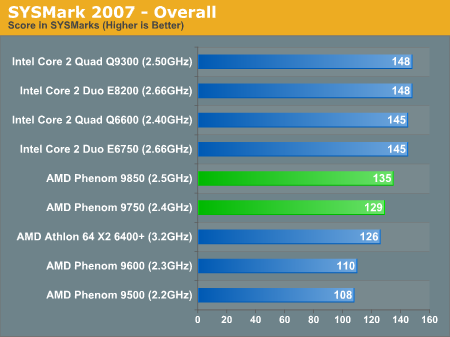
The new Phenom processors are finally within striking range of Intel, while the Q6600 still manages a 7% lead over the X4 9850 the latter is priced a bit cheaper and thus is within the realm of competition.
The fact that the dual core Athlon 64 X2 6400+ manages to almost equal the performance of the 9750 illustrates two points:
1) AMD desperately needs to increase clock speeds of its Phenom line, and
2) Most applications still don't benefit tremendously from four cores, paving the way for AMD's triple core Phenom X3 to clean up in the $150 - $200 space.
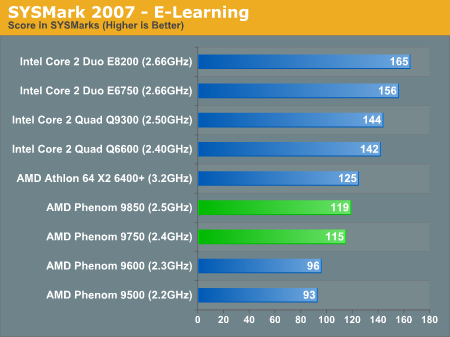
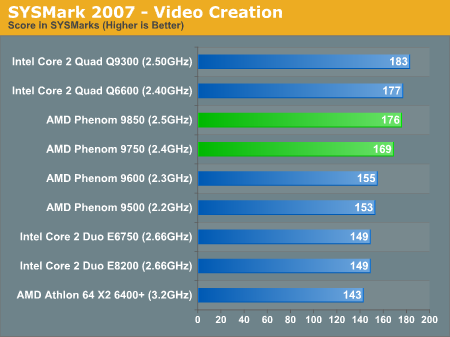
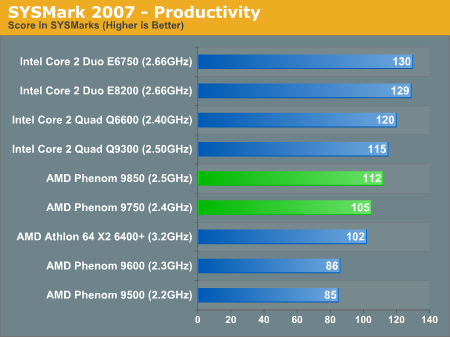
The productivity test shows us something very interesting - the Core 2 Quad Q9300's 6MB of L2 cache (3MB shared per pair of cores) actually makes it slightly slower than the outgoing Q6600, which has a full 8MB (4MB per pair of cores). The rest of the numbers indicate that this is obviously not a problem elsewhere, but it's still worth noting.
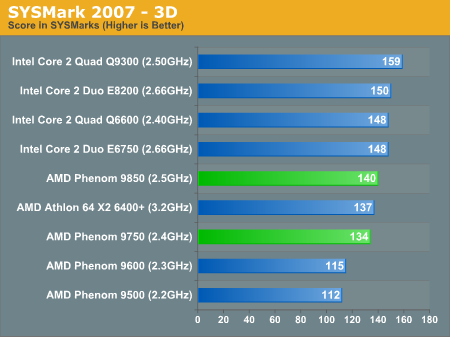
3D Rendering Performance
3dsmax r9
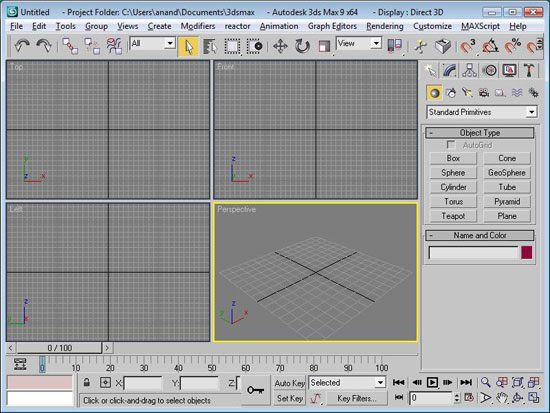
Our benchmark, as always, is the SPECapc 3dsmax 8 test but for the purpose of this article we only run the CPU rendering tests and not the GPU tests.
The results are reported as render times in seconds and the final CPU composite score is a weighted geometric mean of all of the test scores.

The Phenom X4 9850 is once again within 7% of the Q6600 and it's around 11% cheaper, we'd say AMD has a competitive part here. Looking at the Core 2 Quad Q9300 however, we see that if Intel can get its 45nm availability issues solved AMD would have to respond with even better pricing in order to make the X4 9850 as attractive as it is today.
Cinebench R10

A benchmarking favorite, Cinebench R10 is designed to give us an indication of performance in the Cinema 4D rendering application.
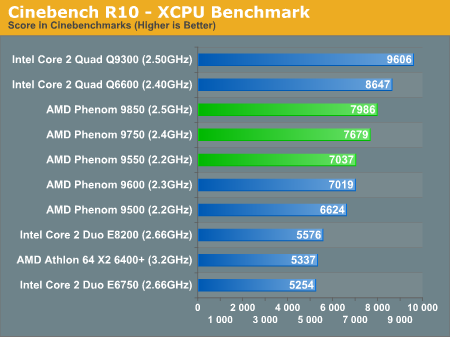
We see more of the same under Cinebench: the Phenom X4 9850 comes close to the Q6600, but the Q9300 comparison isn't nearly as close.
POV-Ray 3.7 Beta 24

POV-Ray is a popular raytracer, also available with a built in benchmark. We used the 3.7 beta which has SMP support and ran the built in multithreaded benchmark.
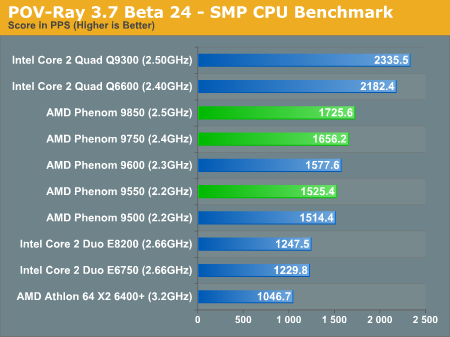
Under POV-Ray the two quad core Intel solutions are a bit much for Phenom to handle, the performance gap widens to over 25% between the Q6600 and the Phenom X4 9850.
High Definition Media Encoding
DivX 6.8 with Xmpeg

Our DivX test is the same one we've run in our regular CPU reviews, we're simply encoding a 1080p MPEG-2 file in DivX. We are using an unconstrained profile and enhanced multithreading is enabled.
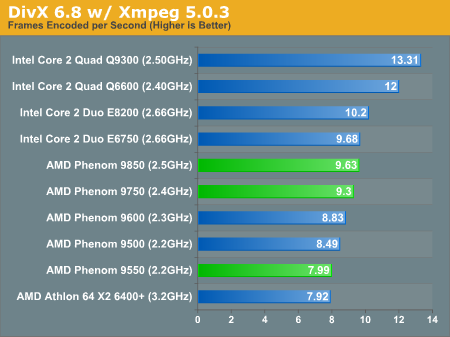
DivX performance continues to be a strong suit of the Core architecture as even the dual core E6750 is able to outperform AMD's fastest Phenom.
Windows Media Encoder 9
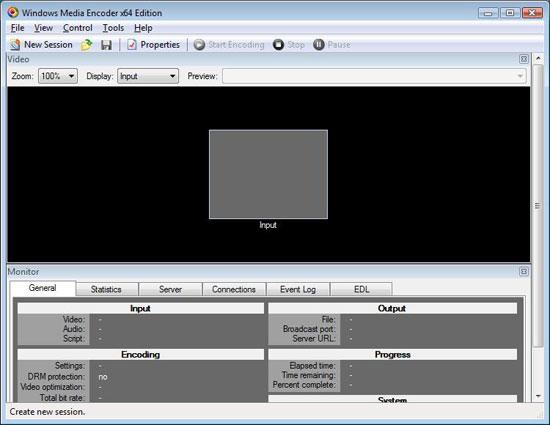
Using Windows Media Encoder's advanced video profile we encode a 500MB AVI file, this is the same test we've run in other CPU reviews.
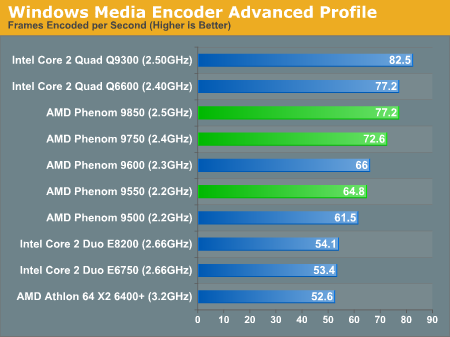
Things are much closer under Windows Media Encoder, with the Phenom X4 9850 actually equalling the performance of Intel's famed Core 2 Quad Q6600. And it's cheaper.
x264 Encoding with AutoMKV
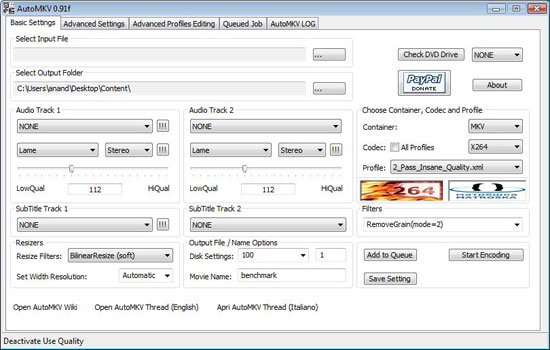
Using AutoMKV we compress the same source file we used in our WME test down to 100MB, but with the x264 codec. We used the 2-pass Balanced encoding profile.
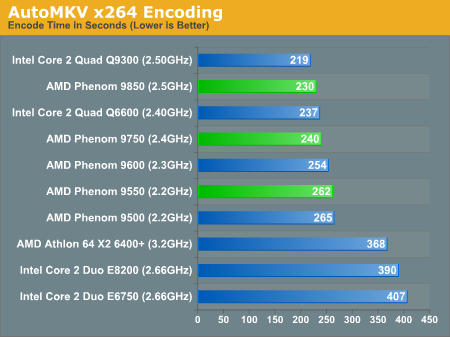
In our x264 encoding test AMD's Phenom X4 9850 is actually faster than the Core 2 Quad Q6600 and begins to nip at the heels of the much more expensive Q9300.
Photoshop and Valve Multithreaded Game Dev Benchmarks
Adobe Photoshop CS3

To measure performance in Adobe's Photoshop CS3 we turned to the Retouch Artists CS3 benchmark. The test cycles through a handful of commonly used filters and is timed manually. We ran the benchmark at its default settings.
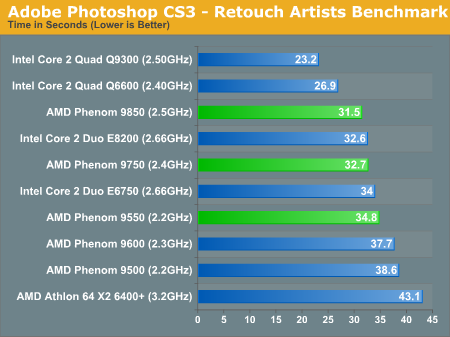
Our Photoshop test favors Intel's Core 2 Quads over the new Phenom processors; the Q9300 will only make matters worse for AMD.
Valve Map Compilation
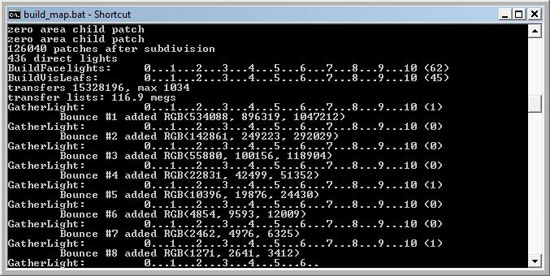
Valve supplied us with their VRAD map compilation tool to measure the performance of compiling Source engine maps.
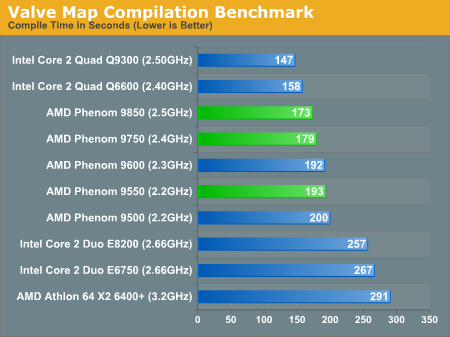
Valve's map compile test has Intel in the lead, but AMD is able to at least keep up with the Q6600.
Valve Particle Benchmark

Particle systems are an important aspect of CPU performance in 3D games, although this benchmark does overstate its importance a bit. However, it does give one aspect of how more cores can be used in future games.
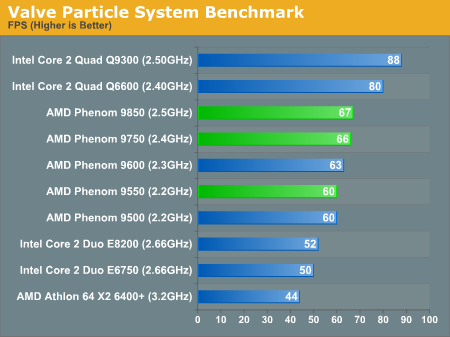
Gaming Performance
Supreme Commander

Supreme Commander is a popular RTS (Real Time Strategy) title that can be very CPU dependent. Our benchmark involves playing back, as fast as possible, a 4-person match and recording the simulation time for the replay in seconds.
We ran Supreme Commander at 1920 x 1200 with High fidelity presets, v-sync was disabled.
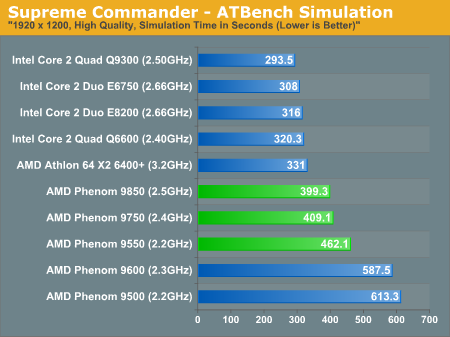
Here's one area where AMD needs pure clock speed to keep up, even the old X2 6400+ is able to outperform the latest Phenom processors. As long as you have two cores you're golden in Supreme Commander, but AMD's K8 and Phenom architectures are clearly slower under Supreme Commander.
Crysis
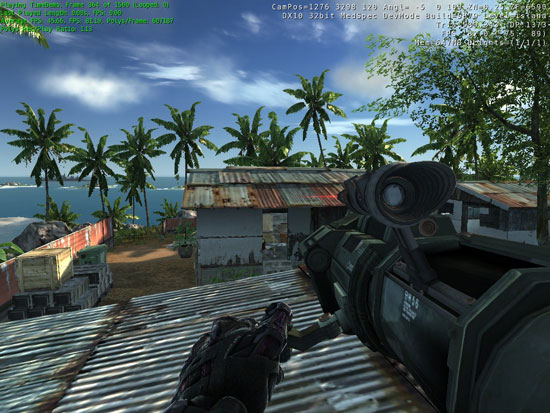
The most demanding FPS on the market right now is Crysis, and we couldn't resist using it as a benchmark. We ran at 1024 x 768 with Medium Quality defaults and used the game's built in CPU benchmark.
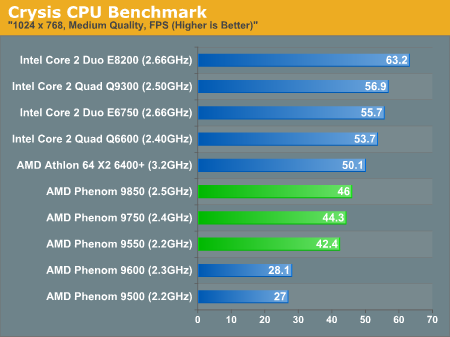
More than anything you're going to be GPU limited with Crysis, but in terms of how well these CPUs handle the workload given to them by the game - Intel continues to take the cake here.
Oblivion: Shivering Isles
Our Oblivion benchmark is the same one we use in our GPU reviews. Oblivion can vary from being CPU limited to GPU limited depending on the scene, we picked one that was GPU limited to illustrate that even with a wide array of CPUs when you're GPU limited, the differences can be little if anything:
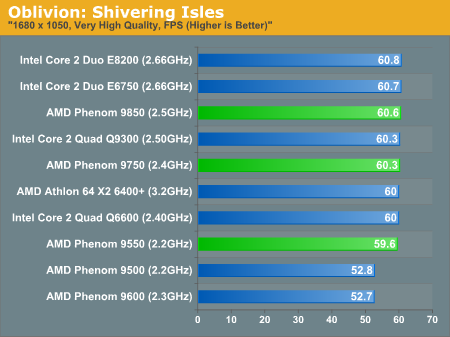
Half Life 2 Episode Two


Half Life 2 is obviously more CPU limited these days, and we continue to see that Intel is ahead of the pack when it comes to pure CPU gaming performance.
Power Consumption
Overall power consumption also has Intel in the lead thanks to the new 45nm parts. Even the old Q6600 still manages to remain competitive here as well.
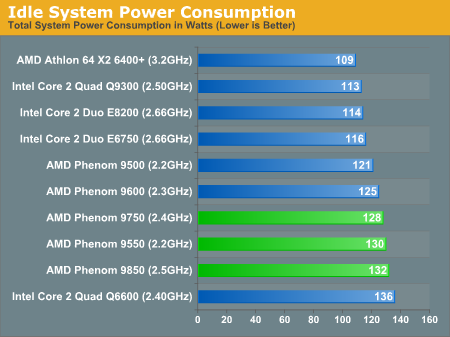

Final Words
Now this is more like the AMD we're used to seeing. It's not quite the performance dominating AMD of years past, but it's a competitive AMD. The Phenom X4 9850 Black Edition is, despite its lower performance in many cases, an actual competitor to Intel's Core 2 Quad Q6600 thanks to its price. The value is even more impressive if you happen to have a Socket-AM2 motherboard that can accept a 9850 as a drop in replacement.
AMD does continue to have some weaknesses, mainly when it comes to DivX and gaming performance and neither of these areas are going to get fixed while remaining on an unchanged architecture. That being said, AMD is standing in a much better space right now and is competitive enough that Intel had better be paying attention.
The Core 2 Quad Q6600 is becoming long in the tooth and could stand a quick transition to the Q9300, which Intel appears to have scheduled for next quarter. The $266 price point, while very aggressive, leaves a lot of room for AMD to come and play in the $175 - $250 space. Intel needs cheaper quad core offerings, especially once AMD starts shipping its triple core Phenom in retail.
If you're building a new system, Intel is still the way to go and once 45nm pricing/availability works out the value proposition will only improve. What's changed is that AMD is now a realistic alternative. Just four months ago there was no point in even considering Phenom, but today it is a viable alternative. If AMD could simplify its lineup a bit and squeeze some extra frequency headroom out of its chips, all while keeping its aggressive pricing we may just have a return to competition in the desktop CPU space.
Exciting times are ahead as well. AMD seems very confident in its 45nm transition, which should bring about higher performance and clock frequencies. Around the same time we'll be seeing the very first Nehalem CPUs from Intel, and before we know it it'll be 2009 and time to talk about Bulldozer. I've always said that AMD had a good roadmap, it just needs to be given the chance to execute on it; these new Phenom processors may able to buy AMD the time it needs to do just that.







